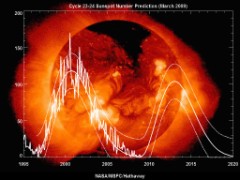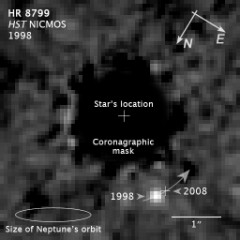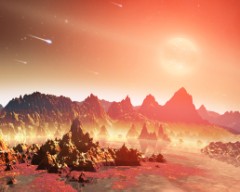There has been a lot happening as of late in the world of astronomy and in this edition we will cover only a small fraction of those goings on, but none the less, we still have some very exciting news to report to all you space fans out there trekking your way across cyber-world. Recent findings strongly suggest the presence of liquid salt water on Mars, it appears we are in a deep solar minimum, a new technique is uncovering exoplanets in old Hubble archival data, and results from the Spitzer space telescope show that some chemicals thought to be necessary for life (as we know it) may not be present around all stars. So lets jump into it shall we.....
Liquid Water on Mars:
Recent analysis of pictures and data taken by the Phoenix Mars Lander strongly suggest the presence of liquid salt water on Mars. If correct this will be the first time that liquid water has ever been directly detected on a planet other than the earth. It has been known that water existed on Mars for some time, but it was thought that it was in frozen and vapor form alone due to the lack of atmospheric pressure and wide temperature swings that dip to well below freezing. This find is primarily due to a series of images taken of material that splashed onto the leg of the lander during touchdown when it fired reverse thrusters to safely land. The thrusters melted a layer of ice just below the surface soil and viola, muddy lander legs. The data collected by Phoenix found the presence of perchlorate salts which include compounds that could lower the freezing point of water which contains them. This data along with the images, which show droplets that appear to have absorbed water from the atmosphere and merged together over a period of a few days, strongly support the hypothesis of liquid water being present.
 | The drops of water, seen here in green, are
shown to slowly come together in this
seriesof images. Credit: NASA/JPL-
Caltech/U. of Arizona/Max Planck Inst. |
Theoretical modeling of just how water would behave in the given situation of the Martian environment also give validity to the claim, “A large amount of independent physical and thermodynamical evidence shows that saline water may actually be common on Mars”, this from Nilton Reno a co-investigator with the mission, adding “Liquid water is an essential ingredient for life. This discovery has important implications to many areas of planetary exploration, including the habitability of Mars.” For years ‘follow the water’ has been the NASA mantra when it comes to Mars and with this startling and amazing find it looks like they are fulfilling that mission. Stay tuned for more updates on this and other water related Mars stories.
For more information visit the link below and our original source:
http://www.ns.umich.edu/htdocs/releases/story.php?id=7041
Deep Solar Minimum:
It is well known that the Sun goes through a cycle of higher and lower activity, with a magnetic cycle of twenty-two years and a sunspot  | Plot of the sunpost cycle from since 1995.
Credit: David Hathaway, NASA.MSFC |
cycle of eleven. Sunspots are large dark areas on the Sun’s visible surface that are intense regions of magnetic activity and appear to go through a cycle in which there are highs (more sunspots) and lows (less sunspots), so it is no surprise that we are now in a period of low activity, in fact we are supposed to be. What is surprising to some however is how just how low the activity seems to be, for by the end of March there were no sunspots for 87 percent of the year so far. 2008 was a year of low activity as well, having no sunspots on 266 of 366 days and many thought that was the bottom and activity would soon pick up. Data from the solar observation craft Ulysses has detected a 20 percent drop in solar wind pressure, which is the lowest since measurements of the solar wind began and other craft have shown that the overall brightness of the Sun has dimmed, from .02 percent in the visible to 6 percent in the ultraviolet. However such lows are not totally out of character for our star, the solar minima of both 1901 and 1913 were both longer and more pronounced, so there is in fact precedence, and much of the records of many aspects of the Sun’s activity don’t go back past the beginning of the space age. Many solar researchers are excited at the opportunity to study the Sun during what appears to be such a deep minima and with the fleet of advanced ground based and space bound technology our ability to investigate the Sun is better than it has ever been. The Sun still holds many mysteries and a lot of reasons for why such deep minima occur is still unknown, but the overall effect on the Earth will be nominal.
For more information on this story visit the following link and our original source:
http://www.nasa.gov/topics/solarsystem/features/solar_minimum09.htmlExoplanets Hidden in Old Hubble Data:
 | The recovered image of the exoplanet in
the old Hubble Data. Credit: NASA, ESA, Z. Levay (STScI) |
Direct images of exoplanets have been hitting the pipeline lately, with the Hubble space telescope’s recent imaging of the planet found to orbit Fomalhaut and ground based observations revealing multi-planet systems it seems as though there is an exoplanet boon lately, and now there is another find to add to the list. David Lafreniere of the University of Toronto has used a new technique to analyze pictures in the Hubble data archives and has found an exoplanet in data nearly ten years old. The object had gone undetected because of the intense light of the parent star. The planet itself had been discovered by ground based observatories in 2007-2008 around the star HR 8799 and is the outmost of a three planets found so far to orbit this bright star. This new technique will be excellent for use with older Hubble data and new as well, and will be able to reveal a set of observations that gives astronomers a better baseline for estimating the motion of the candidate object and verifying that it is indeed a planet. The camera that snapped the archived image is one that sees in infrared wavelengths which can give a better idea of the planetary composition. Hubble has looked at and imaged well over 200 stars for planets and planetary disks and this new technique will be able to view all that data and possibly reveal never before seen planets. This only illustrates that Hubble’s ability and possibility for scientific understanding should not be underestimated and with increases in complimentary methods and technology who knows what the limit is.
For more information on this visit the following link and our original source:
http://hubblesite.org/newscenter/archive/releases/2009/15/full/
Cool Stars, Different Chemicals:
Using the infrared Spitzer space telescope a team of scientists have surveyed different types of stars looking for a certain compound, hydrogen cyanide, that is a part of what is known as ‘pre-biotic’ chemistry; chemicals thought to be necessary for the formation of life. What the team
 | Artist's conception of a planet around a cool
star. Credit: NASA/JPL-Caltech |
found from the survey was that certain key compounds thought to be key ingredients for the formation of life as we know it were lacking in the environments around cooler and smaller stars than the Sun, like M-dwarfs and brown dwarfs. Hydrogen cyanide is a key part of adenine, which is a fundamental component of DNA and since all life on Earth has DNA it is thought to be a significant part of the chemistry that leads to life elsewhere. Stars are born inside a large cloud of dust and gas that will eventually become a proto-planetary disk, out of which planets and the rest of the system is formed. Our solar system is thought to have formed in such a way and envelope of compounds in the disk are thought to have rained down on the primordial Earth in the form of meteorites and comets, providing the key ingredients for the life we are. When looking at other Sun like stars the team did indeed find the hydrogen cyanide in some of them, it was just the cooler stars that lacked it. It is thought that one reason is a smaller amount of ultraviolet radiation, which may be a part of the process that produces the hydrogen cyanide. Recently several planets have been found around these smaller type stars and some of those planets are thought to be what is known as a ‘super-earth’, which just means that they are a large terrestrial (or rocky) planet, rather than a gas giant like Jupiter or Saturn. Astronomers have wondered if life could exist on some of these discovered planets but this finding puts another factor that will weigh heavy on the consideration of such possibilities.
For more information on this story visit the following link and our original source:
http://www.nasa.gov/mission_pages/spitzer/news/spitzer-20090407.html
|

